Use this free retelling unit of study to help your kindergarten and first grade students learn how to retell a story.
This is another free resource for teachers and families from The Curriculum Corner.
This free retelling unit of study will be a great addition to your early learning reading workshop.
This download will give you mini-lessons, anchor charts, graphic organizers and other activities to complete with your children.
We have just updated this unit of study to include a document that contains the written out lesson plans as detailed in this post. This is for those of you who like to print a copy to add to your reading binder.
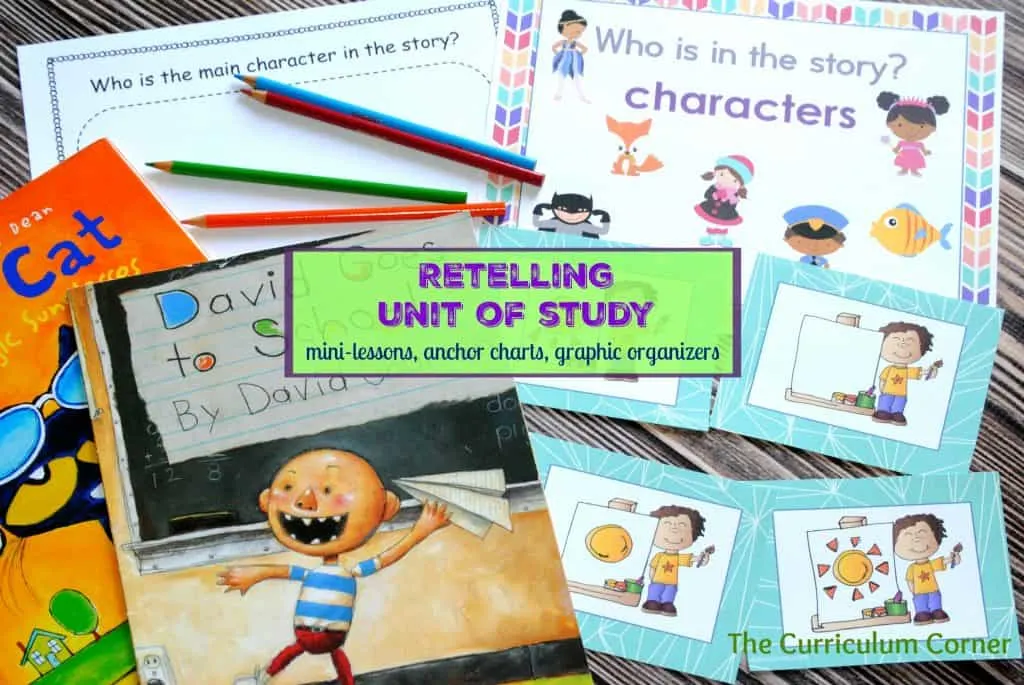
What will children learn from a retelling unit in kindergarten?
- This unit begins with a focus on story elements to build a foundation.
- Lessons on characters, setting, problem and solution are included.
- They will illustrate their comprehension of fiction stories.
- In the end, the goal is for students to be able to retell what they have read or listened to.
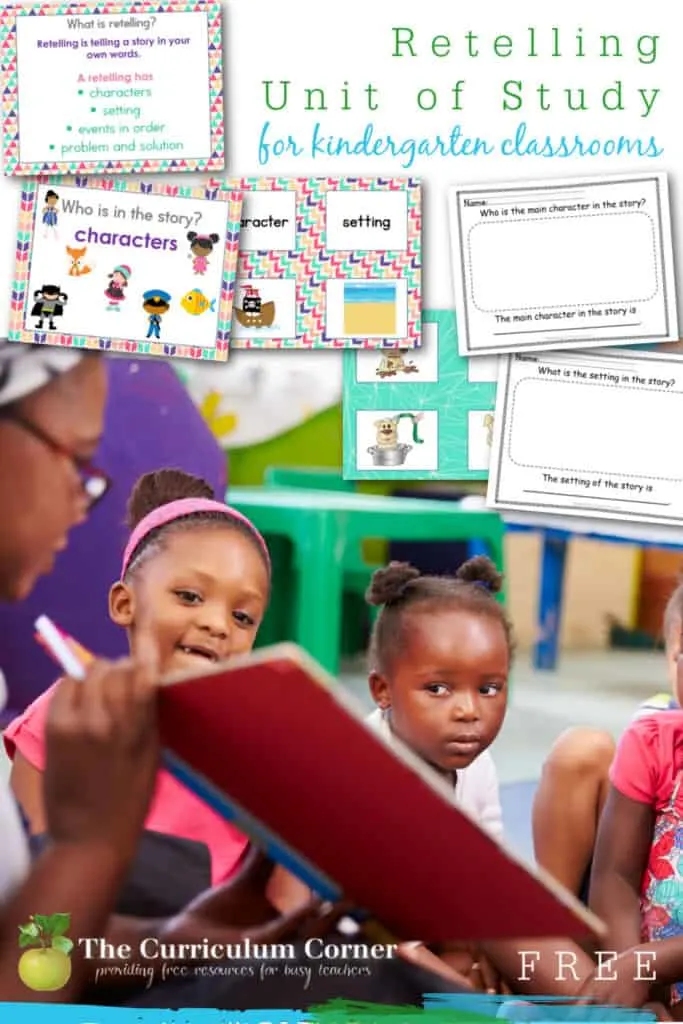
Lesson 1: What is Retelling?
Students need to understand what we mean by “retelling” a story. Many times when asked to retell, they will simply open the book and attempt to read it to you.
- Use our Retelling Anchor Chart to help your students understand what you are asking them to do.
- A good retelling should have… characters, setting, events in order and problem & solution.
- We suggest that you display the anchor chart, but cover up the bottom concepts so that you can focus on just one thing at at time. (We have provided two of these – one with just the elements, and one with a short explanation of each story element).
- For this lesson, you will only focus on the line that says “Retelling is telling a story in your own words.” Use a wordless book such as Tuesday by David Weisner or Pancakes for Breakfast by Tomie dePaola. Flip through the book a few times showing pictures, then close it and have class help to retell the story verbally. You might want to record their retell on chart paper, then open the book to look at the pages again and see if their retell included important parts.
- An additional idea is to use a second wordless picture book (you would need several copies) and have small groups or partners look at the pics and retell as you circulate.
Send home reading reminder slips to explain to families what you are doing in the classroom. There are a total of five slips in this download. You will use them at different points in the unit.
You can download these reminders here:
Lesson 2: Practice Verbal Retelling using Personal Stories
Many kids love to tell stories about their families or something they have recently done.
- Begin this lesson by pulling your class together and brainstorming some ideas for how to think of personal stories (an event in their life, a place they went, etc).
- Next, explain the directions for the First… Then… Last graphic organizer. This organizer has a series of boxes for students to draw pictures in after sharing their stories verbally with partners.
- Once you have given students time to share with partners and draw pictures, have a few of them use their organizers to share their retells aloud in front of the class.
Lesson 3: What are Characters?
Since we have very young learners, we need to make sure that they know what the term “character” in a story means. For this lesson we have created a What is a Character? Anchor Chart that you can use to facilitate a discussion about characters.
Be sure to address the fact that some characters might not be people, but animals, superheroes or maybe even robots.
- Find a book from your classroom library that contains a lot of characters.
- Use our Who is a Character organizer to model how to create a list of all the characters with the class. You might want to model how they can copy the name from the book if they need to.
- As students do their independent reading today, you can have them do this for a book that they are reading, or you might want to use our half-sheet Character Exit Tickets to do a quick check for understanding. (We have created two versions of both of these resources – one with just a box for pictures/words and another that contains a line for students to write the name of a character. Some students will be ready for writing a name, while others might not.)
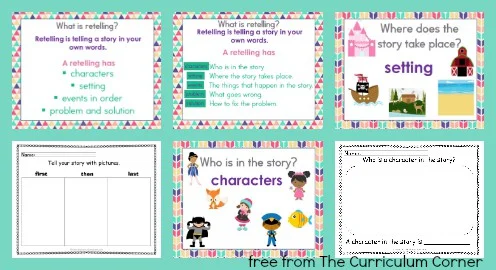
Lesson 4: What is a Main Character?
For this lesson find a story that has lots of characters, but one with a very obvious main character. One suggestion is the book Chrysanthemum by Kevin Henkes.
- Read the story aloud to your students and then list all the characters. (You can use the previous lesson’s organizer for this.)
- Then ask your students who they think the story is mostly about.
- Discuss some of the events that occurred and how Chrysanthemum is the most involved (her actions, her feelings, her words). Model the Main Character Graphic Organizer for students.
- Next, have a stack of books ready to show the class that have the names of the main characters in the title. Tell students that many times the main character’s name will appear in the title. (Suggestions: David, Pete the Cat, Scaredy Squirrel, Amelia Bedelia, Froggy, Tacky the Penguin, other Kevin Henkes books).
**If you feel your students are ready (or for a second lesson on main character) you can also show KnuffleBunny by Mo Willems as a non-example. In this case KnuffleBunny is not really the main character. It is the little girl who loses KnuffleBunny. Tell them they will need to be careful because it is not always the case that the main character’s name will be on the front cover. You could also show other non-examples too – where the title doesn’t contain a character’s name at all. Students need to know that they have to read the story to make sure the main character they identify is the one the story is mostly about.
For this lesson we have also provided a Main Character Exit Slip you can use as a quick check at the end of independent reading.
Lesson 5: What is the Setting of a Story?
This is very similar to the Character lesson from above, but for this lesson we need to make sure the students know what the term “setting” in a story means.
- For this we have created a What is the Setting? Anchor Chart. You can use it to facilitate a discussion about settings in a story.
- This chart can also serve as a visual reminder to students about what settings can be in a story. Pick a book to read that has a more unique setting. Some suggestions are Tacky, the Penguin by Helen Lester, Tooth Trouble by Jane Clarke, The Selfish Crocodile by Faustin Charles, Bill and Pete by Tomie dePaola or perhaps a fairy tale where the setting is a castle. (We like starting with stories where the setting is not a home or a school. That is what students most likely already understand because those are the settings in their own lives. We want them to get examples of other types of settings that might be a little more unfamiliar.)
- Read the story and then talk about how to figure out the setting. Sometimes an author will name the setting in the first few pages, but other times we will need to use the pictures as clues to let us know where the story is happening.
- Refer to the anchor chart to look at some other examples of settings. Use our What is the Setting? Organizer to model how to figure out and draw the setting of the story.
- As students do their independent reading, you can have them complete this graphic organizer for a book that they are reading, or you might want to use our half-sheet Setting Exit Tickets to do a quick check for understanding. (We have created two versions of both of these resources as well – one with just a box for pictures/words and another that contains a line for students to write the name of the setting in the story.)
**For added practice, we have created a quick Character & Setting Sort that you can use for a center or performance assessment. It contains five examples of characters and five examples of settings for students to sort into appropriate groups.

Lesson 6: Settings Can Change in a Story
We also want to teach our students that settings can sometimes change in a story. While many stories take place in just one setting, sometimes characters travel to different places and the setting can change for the rest of the story or for just a part of the story.
- For this lesson, think of a book where the setting in the story changes one or two times. Mercer Mayer’s Just Grandma and Me is a suggestion, but many Clifford and Curious George books could also provide good examples. You may have something in mind that would work very well.
- Model the Settings Can Change graphic organizer for students after reading the book and discuss how the setting changed within the book.
- Since settings changing is specific to certain books, assigning this for independent reading won’t work very well. We suggest you give this to students during individual conferences as you see their books support its use or you could use this with a small guided reading group if a story changes settings.
Lesson 7: What are Events in a Story?
Discuss what an “event” in a story is – “something that happens in a story”.
- Read a story of your choice aloud and then model the Events Graphic Organizer by drawing and/or writing about six events that happened in the story.
- You will want to talk about making sure they are important events or “big” events as opposed to small details that don’t really matter to the story.
- For added practice, you can read another story the next day and have students work independently on the organizer after discussing the story.
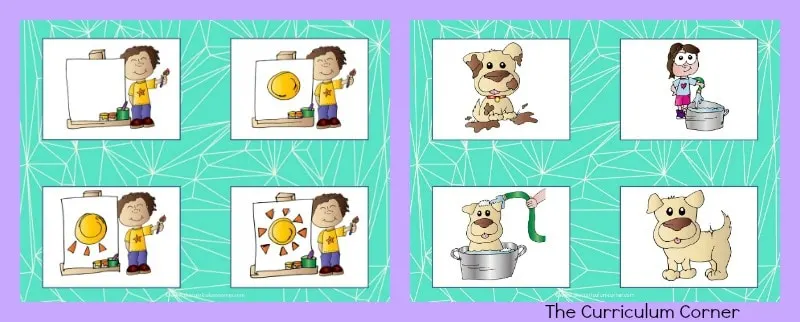
Lesson 8: Sequencing Events
We want our students to understand that a logical sequence is extremely important in retelling a story because it won’t make sense if the events are out of order.
- To help students understand the importance of sequence, pass out the Sequence Picture Cards to small groups of students and ask them if they can work together to put the pictures in an order that makes sense. (We have provided five sets, but you will want to keep one back to practice and discuss as a group. You may want to think about printing multiple sets of some of the cards if you want several small groups or partners.)
- Circulate the room as students work and once they have the cards in order, they can talk to you about that order and why they put the cards in that sequence.
- Once you have talked to all groups briefly, pull the class together and order another set of pictures in a logical sequence as a class.
- Discuss why they need to be in a specific order (because some events have to take place before others can – use specific examples from the pictures – you can’t have a flower before you plant a seed). Let them know that it is the same with stories, so it is important to tell the events in order so that the story makes sense.
Lesson 9: Identify the Problem & Solution
Finally, before we can get students started effectively retelling stories, we need to teach them the significance of problem & solution in fiction stories.
- One fun way to begin this is to show a funny video clip and follow it with a discussion about what the terms “problem” and “solution” mean. We found this funny clip about a pig trying to get cookies off the top of a refrigerator: Ormie the Pig Problem & Solution Clip. Take a look to see if it is a good fit for your kids or find another clip on YouTube that works best for you. (You could also use a short clip of a favorite Disney film or popular children’s movie.)
- Use our Problem/Solution Graphic Organizer to model how to draw or write about the problem & solution in the video.
- Then, to make sure your students have a firm understanding, spend a few days reading various stories that have a very clear problem and solution framework.
- Continue to model how to use the graphic organizer. If any (or all) of your students are struggling with this concept, concentrate solely on the problems in stories for a bit until that understanding is solid. We have a Problem Graphic Organizer you can use if you need to do this first and then you can move on to the other.
Lesson 10: Retelling a Story
We have found that the best way for students to become better at retelling stories is to have LOTS of modeling followed by lots of practice. This will simply involve you constantly and consistently modeling the skill in your Reader’s Workshop mini-lessons, small guided reading groups and reading conferences.
- Many teachers are familiar with something called the “Five Finger Retell” which is a way for students to make sure they include all the important parts in their retell.
- Other teachers prefer something simpler that involves simply a beginning, middle and end – in which they incorporate the characters and setting into the beginning portion of the retell.
- We have provided both of these types of Retell Graphic Organizers so that you can decide which works best for your class or specific students. Be sure to model the organizers you wish for your students to use so that they understand how to use them.
You can download this free unit of study here:
You can download the lesson descriptions here: Lesson Plans
You might be interested in adding the following books to your classroom library (contains affiliate links)
Looking for other free reading ideas for your classroom? Try these freebies we have created:
As with all of our resources, The Curriculum Corner creates these for free classroom use. Our products may not be sold. You may print and copy for your personal classroom use. These are also great for home school families!
You may not modify and resell in any form. Please let us know if you have any questions.

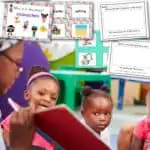
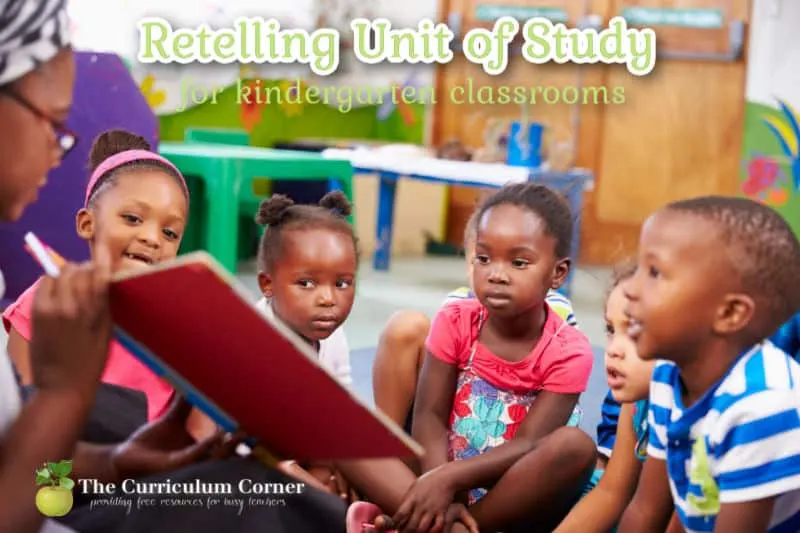
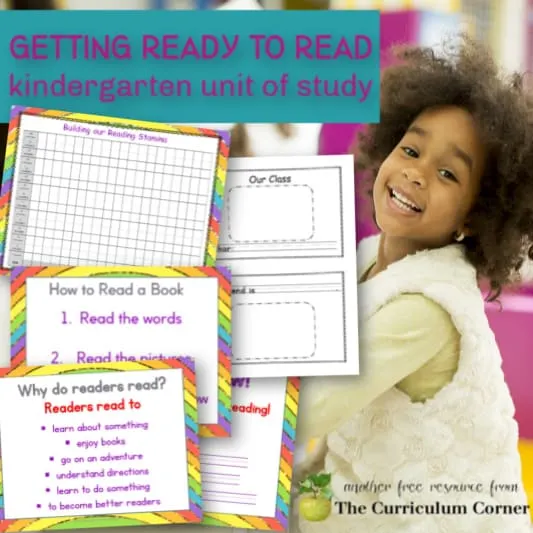
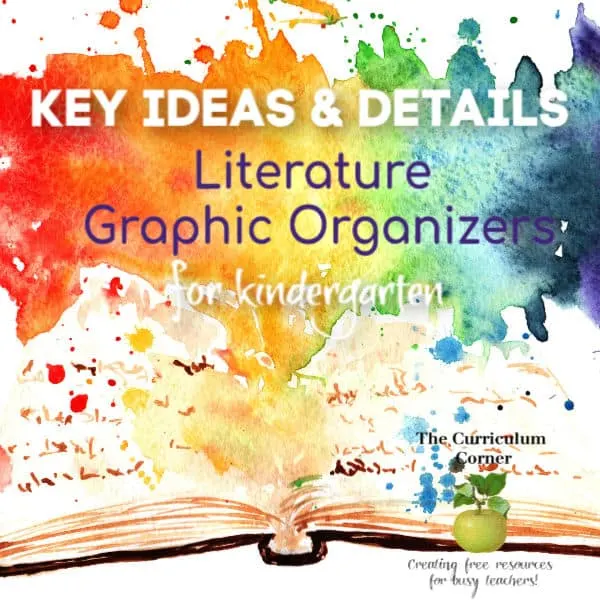
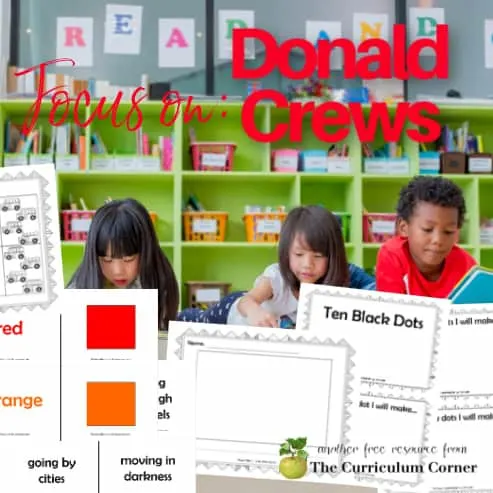
Graphic Organizers for Informational Text - The Kinder Corner
Wednesday 21st of April 2021
[…] Retelling Unit of Study […]
Graphic Organizers for Literature - The Kinder Corner
Wednesday 21st of April 2021
[…] Retelling Unit of Study […]
Leah
Wednesday 21st of August 2019
This is perfect. Thanks!
Elements of Literature Unit of Study - The Curriculum Corner 123
Tuesday 7th of August 2018
[…] You will find a coordinating unit of study on The Kinder Corner designed for younger learners. Retelling Unit of Study for Kindergarten […]
Krista Edwards
Friday 16th of October 2015
Retelling unit of study for Kindergarten is perfect! I like the idea of sequencing cards...to help explain and reinforce that it's important to tell (retell) the story in order b/c otherwise it won't make sense! The combination of pictures (graphics/visuals) to help teach and then the templates that allow them to both draw and to write some are perfect! Thanks so much!